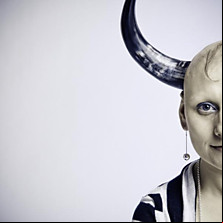BBC Review 1bj6o
At heart an album of real songs with real emotions for real people.
Colin Irwin 2010
If geography and environment can shape music then it’s certainly had a profound effect on this striking and sometimes startling album. Inge Thomson is from Fair Isle – a small, remote island halfway between Shetland and Orkney – and its sense of wildness and isolation is seemingly the defining influence on Thomson’s highly individual and occasionally eccentric approach as a singer, songwriter and multi-instrumentalist.
Perhaps best-known previously for her accordion work with the Karine Polwart Band, Thomson’s intimately innovative style has also evolved via disparate spells with folk-pop group Drop the Box, the rampaging band Harem Scarem and an intriguing collaboration with Bonnie ‘Prince’ Billy, but this debut solo album still sounds totally off the wall, fitting no conventional criteria of genre.
Ablaze with oddity and starkness, it pays plenty of homage to her own rich pedigree in traditional music, interspersed with electronic glitches redolent of the Four Tet school of folktronica, which give it a boundary-defying intensity. It has a sense of mystery, eeriness and adventure emphasised by the darkly atmospheric Scoundrel Clouds, undercut with a haunting kaleidoscope of voices recorded in an ancient monastery carved into a mountain in Armenia.
Such unselfconscious fearlessness gives the album a rare edge. Her husband Martin Green (of Lau) adds electric piano and effective programming and there are additional contributions from guitarist Tom Cook and singer Heidi Talbot to add further texture to Thomson’s own breathy vocals and wonderfully bizarre narratives, like the Björk-esque Girl With the Swan’s Head, the desolate Marie Celeste, the beautifully bleak Norseman’s Bride and the spiky Where Do I Sign?
Disquieting hymn-like backdrops and evocative seascapes reflect the overriding spirit but there’s mischief and fun, too, both in Thomson’s warmly impudent accordion and the subtle minimalism of the arrangements. A plinking banjo suddenly pops up in Cycle, an infectious clippety-clop rhythm invades John and there’s a telling duet with Rory Campbell on the gorgeous love song How Far.
Despite all the bleeping weirdness and the slightly deranged moods it summons, this is still at heart an album of real songs with real emotions for real people. That in itself is something of a rarity.



